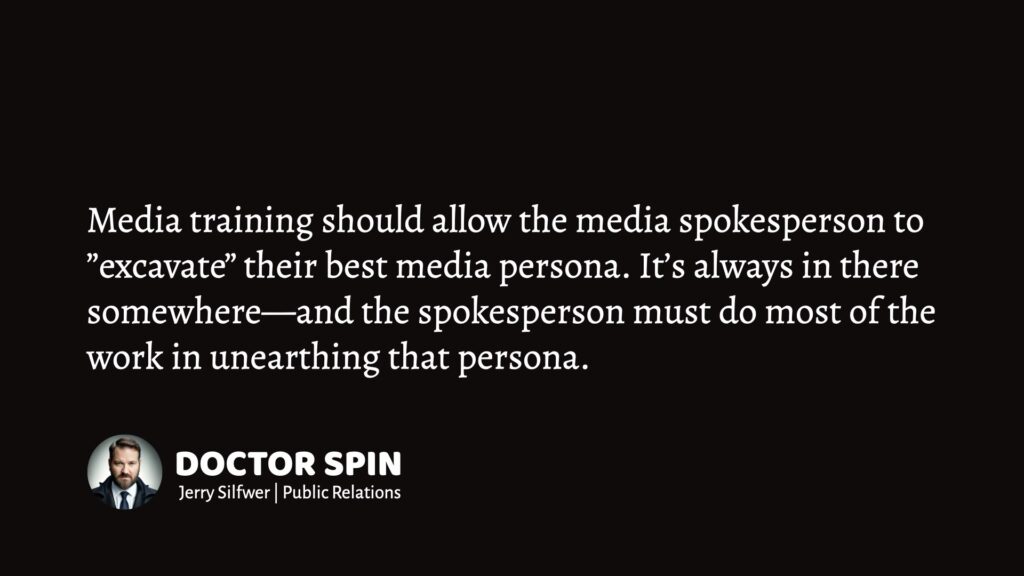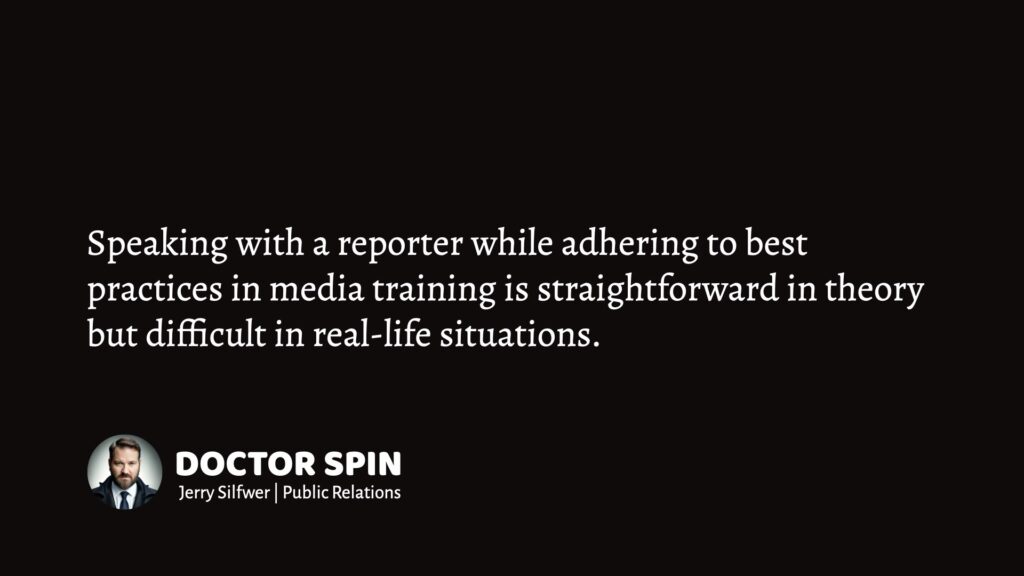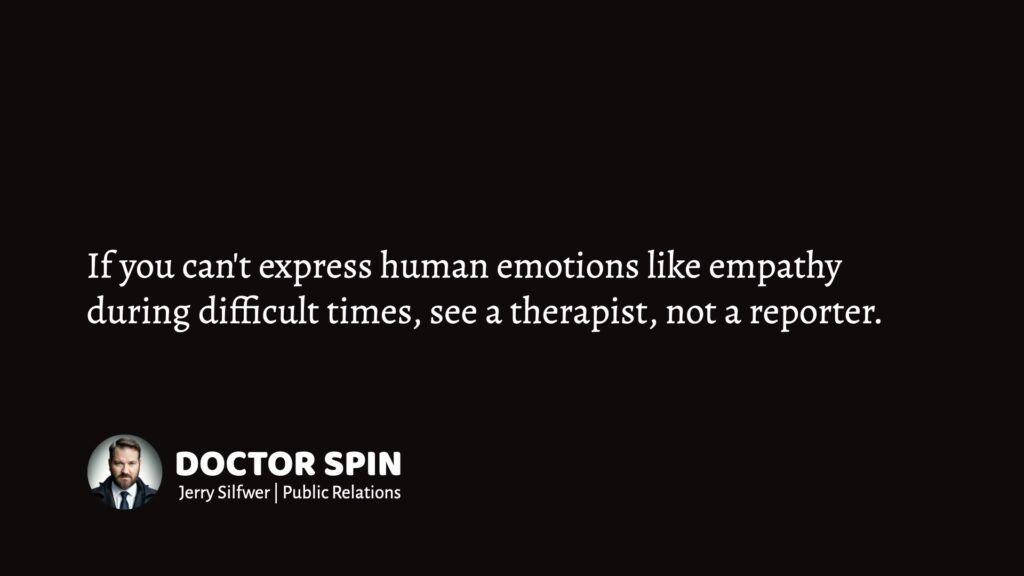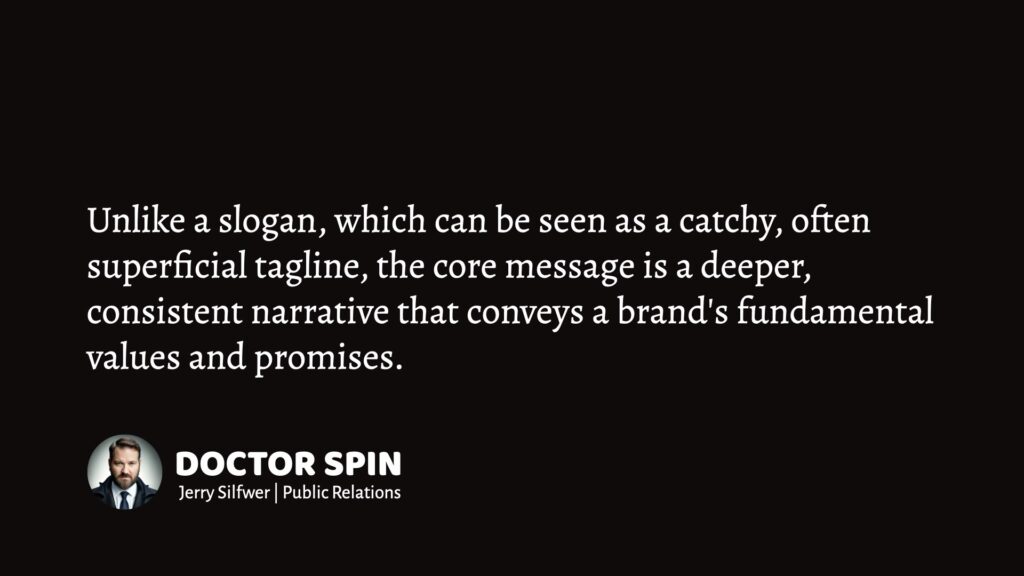How do you train a media spokesperson?
Since 2005, I’ve been training media spokespersons and pitching their stories. As an introvert, I respect anyone who enters the spotlight consciously.
Becoming a successful media spokesperson can be daunting, but the outcome is valuable for both the organisation and the individual.
Here we go:
People Connect With People
We often talk about how people connect with different brands.
But this kind of talk is usually a bit… off the mark.
Sure, we know brands.
But do we connect with brands?
What we do is that we connect with people. And this is why it’s so important to have decent spokespersons — no matter the organisation’s size.
Sure, we do have the ability to anthropomorphise. A brand’s unique voice can be established.
But if you want people to connect with your brand, you must populate your external interface with humans.
So, how do you train a media spokesperson?
Media Spokesperson Training

Spin Academy | Online PR Courses
Media Spokesperson Training
I love coaching media spokespeople. Here’s how to approach your very first media training as a media trainer yourself:
Learn more: Media Spokesperson Training: Get Your Message Across
💡 Subscribe and get a free ebook on how to get better PR ideas.

Why Camera-Training Works
In our heads, we have these ideas about ourselves. From a PR coach’s perspective, these ideas are generally too biased to be helpful.
People with confidence think they’re funny, cool, or good-looking. People without confidence believe they are boring, awkward, or ugly. People in between tend to over-compensate left and right to find some balance that isn’t there.
“Wouldn’t it be great if I always used this catchphrase or if I always wore yellow-tinted sunglasses indoors?”
Well, maybe you can work those things out with your therapist later.
If I sit down and talk to these people about how they want to be perceived, we enter the world of therapy. Not spokesperson training.
Think of stand-up comedians who work hard for decades (and sometimes their whole careers) to be themselves on stage.
When there’s a stage, a microphone, and an audience, our narcissistic biases go haywire, and we start acting unnaturally. And this is what hitting the record button on a video camera will simulate.
This is why I prefer to start working directly, not with biased self-images, but with what’s right then and there — on camera.
Classic Media Training Advice

Spin Academy | Online PR Courses
Classic Media Training Advice
Speaking with a reporter while adhering to best practices in media training is straightforward in theory but difficult in real-life situations.
Here is some classic media training advice:
Learn more: Classic Media Training Advice
💡 Subscribe and get a free ebook on how to get better PR ideas.

Classic Media Training Mistakes

Spin Academy | Online PR Courses
Classic Media Training Mistakes
Standing before a camera or a microphone can be stressful, especially during a crisis. Therefore, many leaders, politicians, and communication professionals invest in professional media training.
However, media training can be taken too far.
Answers Without Substance
Exaggerating the Bridge Technique
Parrotting Your Key Message
Staring Down the Reporter
Relying on Non-Apologies
Using Platitudes and Jargon
Transposing Human Emotions
Learn more: Classic Media Training Mistakes
💡 Subscribe and get a free ebook on how to get better PR ideas.

Media Spokesperson Selection
Training to deliver messages to an audience is paired with sometimes conflicting ideas of identity.
Many fantastic public figures have certain trademarks that allow them to stand out. I know of an excellent Swedish economics professor who often makes public appearances in his T‑shirts, long black hair, and black-painted fingernails.
But that’s not where it begins. Maybe you rock black fingernails, but those fingernails must be what remains after you’ve removed everything that’s not you. Finding your spokesperson persona is a process of elimination, not a method of adding quirky trademarks.
Eventually, trying out creative ideas to spice up public appearances or develop personas can be great fun. But it’s not a good place to start. Some argue that spokespeople should be charismatic, good-looking, intelligent, knowledgeable, and witty.
In my experience with coaching spokespeople, those traits are liabilities long before they become assets. If we’re in a hurry, I’d prefer someone Stoic.
This is not just because Stoicism looks good on camera but also because a Stoic person is more likely to accept that practice, experience, and rigorous preparedness are the way to go.

Thanks for reading. Please support my blog by sharing articles with other communications and marketing professionals. You might also consider my PR services or speaking engagements.
PR Resource: The Stoic PR Professional
Spin Academy | Online PR Courses
PR and Stoicism
I’m inspired by Stoicism — and intrigued by the idea of translating classical Stoic virtues (wisdom, courage, justice, temperance) and applying them to public relations:
The Wisdom Pitch
“A Stoic is someone who transforms fear into prudence, pain into transformation, mistakes into initiation, and desires into undertaking.”
— Nassim Nicholas Taleb
Tell PR stories of how organisations can be wise and overcome obstacles that have stopped others in their tracks. Convey PR messages on how to apply wisdom, knowledge, and experience.
The Courage Pitch
“We cannot choose our circumstances, but we can always choose how we respond to them.”
— Epictetus
Tell PR stories of brands that never back down in the face of hardships that would destroy other organisations. Convey PR messages of how an organisation can be righteous even when storms are raging.
The Justice Pitch
“Concentrate every minute on doing what’s in front of you with precise and genuine seriousness, tenderly, willingly, with justice.”
— Marcus Aurelius
Tell PR stories of how organisations relentlessly can strive for honesty and transparency — even when uncomfortable. Convey PR messages about how all brands, without exception, can rid themselves of dishonesty and incompetence.
The Temperance Pitch
“It’s not the man who has too little, but the man who craves more, who is poor.”
— Seneca
Tell PR stories of organisations that strive for higher values in a world where all other organisations suffer shortsightedness. Convey PR messages of organisations prepared to abstain from short-term gains to make the world better for all.
Learn more: Stoic Philosophy for PR Professionals
💡 Subscribe and get a free ebook on how to get better PR ideas.

PR Resource: The High Road Tonality
Spin Academy | Online PR Courses
The High Road Tonality
An organisation is the polyphonic sum of all its coworkers. Imagine taking the most mature traits from each coworker and combining them into one voice — the High Road Tonality.
Learn more: The High Road Tonality: Don’t Be Pushed Around
💡 Subscribe and get a free ebook on how to get better PR ideas.

PR Resource: The Paradox of Prominence

Spin Academy | Online PR Courses
The Paradox of Prominence
The ever-looming “dark side” of what drives people’s interest can be challenging for public relations (PR) and communications professionals. This phenomenon, where every strength inherently possesses a corresponding downside, can be called the “paradox of prominence.”
An example of this paradox is the halo effect, where physical attractiveness becomes an asset for a spokesperson. Attractiveness often leads to positive biases; attractive individuals are frequently perceived as more credible and competent. 10Eagly, A. H., Ashmore, R. D., Makhijani, M. G., & Longo, L. C. (1991). What is beautiful is good, but…: A meta-analytic review of research on the physical attractiveness stereotype. … Continue reading 11Silfwer, J. (2023, December 17). The Halo Effect: Why Attractiveness Matters in PR. Doctor Spin | The PR Blog. https://doctorspin.net/halo-effect/
However, this same attribute can spark negative reactions. Critics might claim that the individual’s success or visibility is primarily due to their looks, undermining their competencies. This duality illustrates how the qualities that draw positive attention can simultaneously attract criticism and scepticism.
Competence, another valuable trait, often encounters similar pitfalls. Highly competent individuals inspire confidence and admiration. Nevertheless, this competence can be perceived negatively when willfully interpreted as arrogance. Studies suggest that while competence garners respect, it can also lead to social penalties, such as envy and resentment. 12Fiske, S. T., Cuddy, A. J. C., Glick, P., & Xu, J. (2002). A model of (often mixed) stereotype content: Competence and warmth respectively follow from perceived status and competition. Journal of … Continue reading
Examples of the Paradox of Prominence
The paradox of prominence seems to be an inherent aspect of human interest dynamics.
| Prominence | Positive Outcome | Negative Outcome |
|---|---|---|
| Physical attractiveness | Enhanced credibility and trust | Accusations of superficial success |
| High competence | Respected and trusted as an expert | Perceived as arrogant or unapproachable |
| Charisma | Ability to inspire and attract followers | Viewed as manipulative or insincere |
| Strong advocacy | Increased support and mobilization for a cause | Target of intense criticism from opponents |
| Wealth | Seen as successful and influential | Resentment and accusations of greed or unfairness |
| Assertiveness | Effective leadership and decision-making | Labeled as domineering or aggressive |
| Innovation | Admired for creativity and forward-thinking | Resistance to change and criticism from traditionalists |
| High visibility | Greater recognition and influence | Increased scrutiny and loss of privacy |
| Generosity | Viewed as kind-hearted and philanthropic | Suspected of ulterior motives |
| Success in competitive fields | Role model and symbol of achievement | Envy and attempts to undermine accomplishments |
We must recognise that with every increase in visibility, there is a corresponding increase in scrutiny and criticism.
Pick Your Opponents Wisely
Public awareness comes with inevitable costs.
In the quest for greater visibility and influence, it is critical to acknowledge that “being universally well-liked” is a naïve and unrealistic goal.
By strategically harnessing this paradox, public relations professionals can manage public perception by internalising expected “downsides” as additional awareness drivers.
Learn more: The Paradox of Prominence
💡 Subscribe and get a free ebook on how to get better PR ideas.

PR Resource: The Core Message

Spin Academy | Online PR Courses
Core Message vs Slogan
A core message is the foundational concept for all marketing and communication strategies.
Unlike a slogan, which can be seen as a catchy, often superficial tagline, the core message is a deeper, consistent narrative that conveys a brand’s fundamental values and promises.
Core message = the fundamental idea or promise that a brand consistently communicates across all platforms, defining its values and what it stands for in every interaction with its audience.
Slogan = a catchy phrase or series of words used in marketing and advertising to quickly capture attention and accurately encapsulate a brand’s appeal or mission.
Together, the core message and the slogan ensure all communications and marketing activities are aligned, reinforcing the brand’s identity and mission across all platforms.
Please note: Seen as a promise, the core message must reflect the organisation’s main advantage over competing organisations. All marketing- and communication activities must reinforce this sentiment more clearly than any efforts by their competitors.
Core Message vs Slogan Examples
These examples showcase how the core message communicates a deeper, ongoing mission or customer promise. In contrast, the slogan is a catchy, immediate hook that complements and enhances the core message.
Red Bull
Apple
McDonald’s
Microsoft
Ikea
Nike
IBM
Spotify
Learn more: The Core Message
💡 Subscribe and get a free ebook on how to get better PR ideas.

ANNOTATIONS
| 1 | Silfwer, J. (2024, May 2). The Core Message. Doctor Spin | The PR Blog. https://doctorspin.net/core-message/ |
|---|---|
| 2, 6 | Silfwer, J. (2022, June 28). Media Spokesperson Training: Get Your Message Across. Doctor Spin | The PR Blog. https://doctorspin.net/media-spokesperson/ |
| 3, 9 | Silfwer, J. (2015, October 9). The Platitude Sickness: The Trash of Corporate Writing. Doctor Spin | The PR Blog. https://doctorspin.net/platitude-sickness/ |
| 4, 8 | Silfwer, J. (2020, July 26). When a Public Apology is Warranted (And When It’s Not). Doctor Spin | The PR Blog. https://doctorspin.net/public-apology/ |
| 5, 7 | Silfwer, J. (2020, May 23). Corporate Cringe. Doctor Spin | The PR Blog. https://doctorspin.net/corporate-cringe/ |
| 10 | Eagly, A. H., Ashmore, R. D., Makhijani, M. G., & Longo, L. C. (1991). What is beautiful is good, but…: A meta-analytic review of research on the physical attractiveness stereotype. Psychological Bulletin, 110(1), 109 – 128. https://doi.org/10.1037/0033 – 2909.110.1.109 |
| 11 | Silfwer, J. (2023, December 17). The Halo Effect: Why Attractiveness Matters in PR. Doctor Spin | The PR Blog. https://doctorspin.net/halo-effect/ |
| 12 | Fiske, S. T., Cuddy, A. J. C., Glick, P., & Xu, J. (2002). A model of (often mixed) stereotype content: Competence and warmth respectively follow from perceived status and competition. Journal of Personality and Social Psychology, 82(6), 878 – 902. https://doi.org/10.1037/0022 – 3514.82.6.878 |



